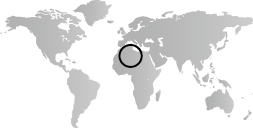A major although gradual change in the period from 2000 to 1000 B.C. is the desertification of the Sahara, which becomes a formidable barrier between Mediterranean North Africa and the sub-Saharan regions to the south.
Western North Africa, 2000–1000 B.C.
Timeline
2000 B.C.
1750 B.C.
1750 B.C.
1500 B.C.
1500 B.C.
1250 B.C.
1250 B.C.
1000 B.C.
Overview
Key Events
-
ca. 1800 B.C.
Like the peoples of Atlantic Europe, the inhabitants of western North Africa build dolmens of huge stones in association with tombs for the prominent dead. The dolmens are of a shape peculiar to the region. Another type of burial, the haouanet, or “little shops,” are very small niches hollowed in rock. Because they are usually too small to contain whole bodies, it has been suggested that they were meant for secondary burial, that is, for bones denuded of flesh in a primary burial.
-
ca. 1500 B.C.
The climate of the Saharan region undergoes a gradual drying out. The desert separates the peoples of the southern Maghrib from the peoples in the north, who maintain contact with other Mediterranean cultures.
-
ca. 1100 B.C.
The Phoenicians, a seafaring people from the Levant, conduct trade in metals from the Iberian Peninsula. They begin to establish colonies on the coast of western North Africa, located along their trade routes.
Citation
“Western North Africa, 2000–1000 B.C.” In Heilbrunn Timeline of Art History. New York: The Metropolitan Museum of Art, 2000–. http://www.metmuseum.org/toah/ht/?period=03®ion=afw (October 2000)
Related
Map
